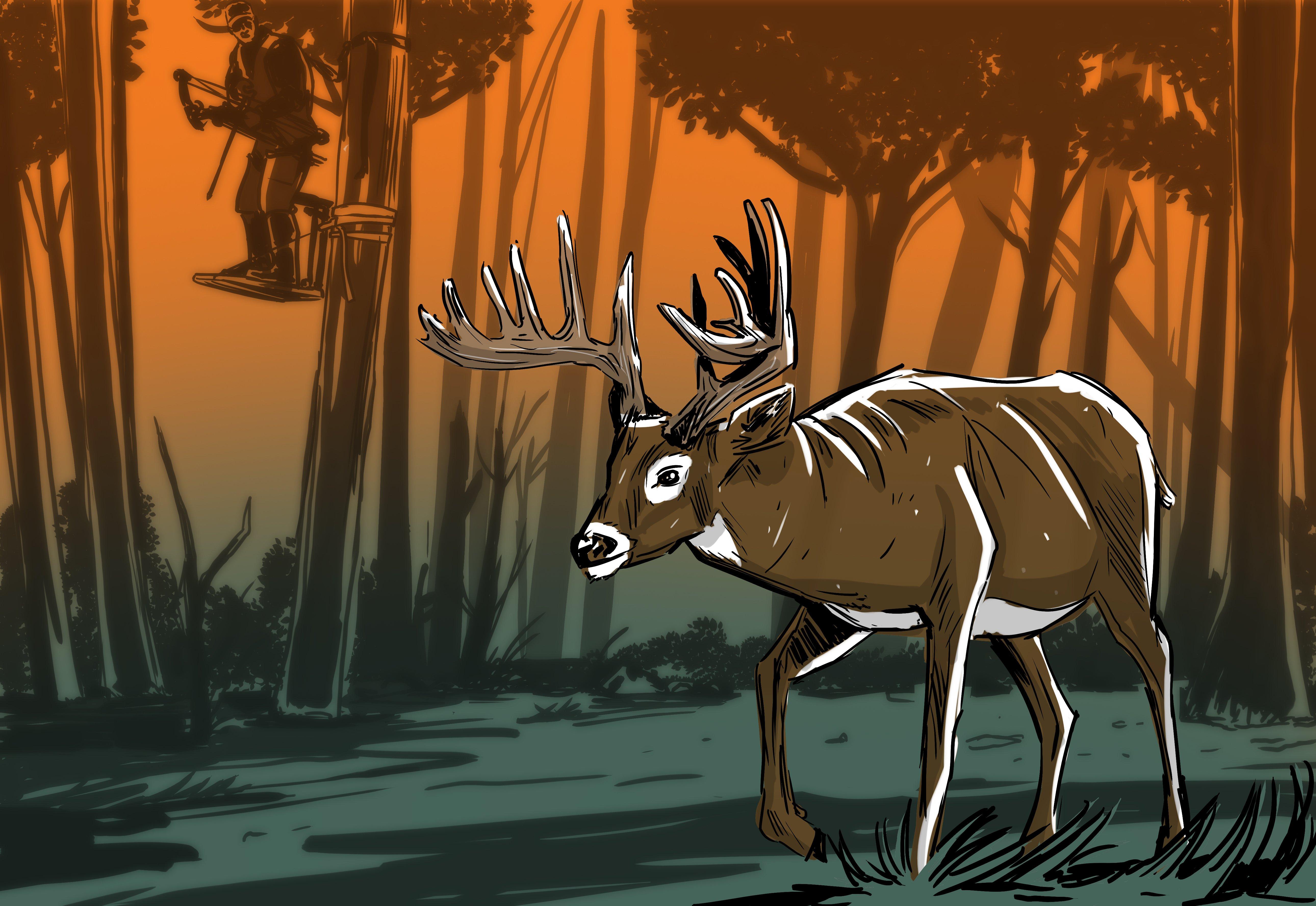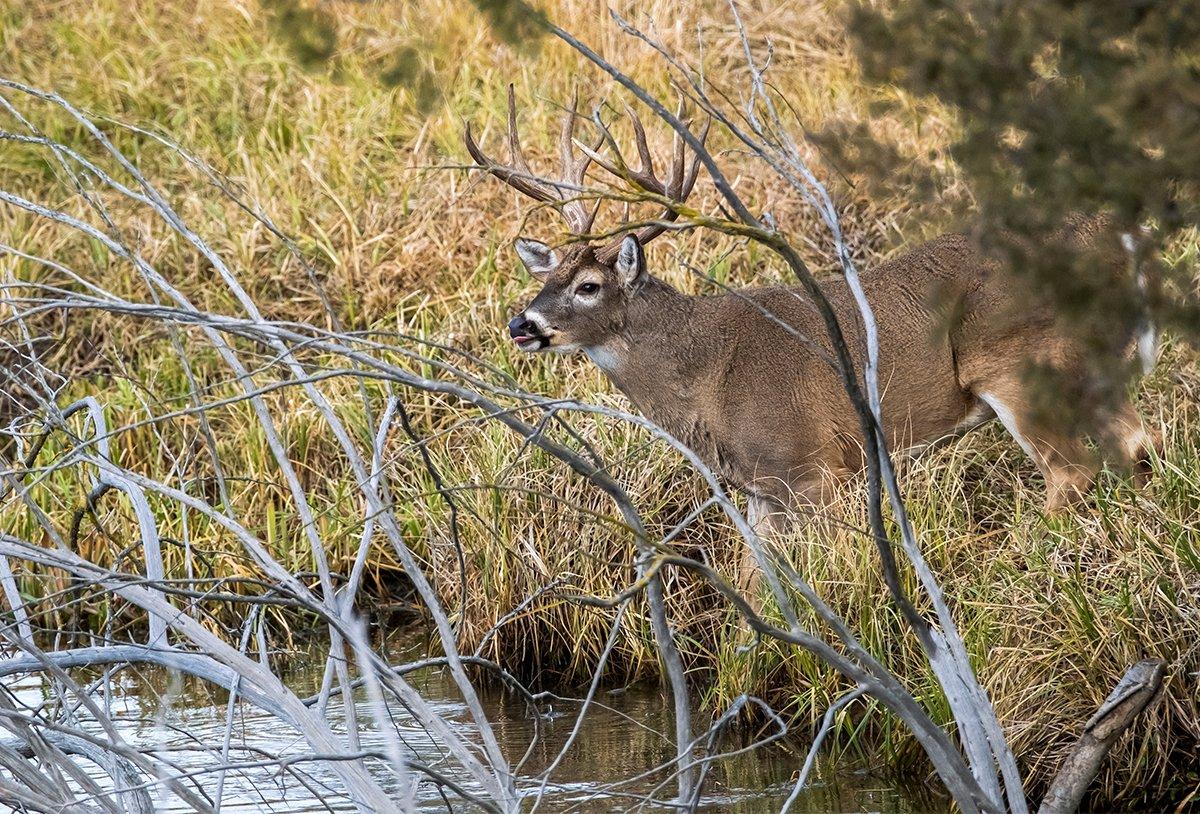With just a few lucky breaks in the weather, the pre-rut, from about mid-October through the first of November, can offer some of the year's best bowhunting
With just a few lucky breaks in the weather, the pre-rut, from about mid-October through the first of November, can offer some of the year's best bowhunting. Mature bucks are antsy as they wait for the first does to pop into early estrus. But they're not roaming far and wide just yet. Instead, they're on their feet more often, including during daylight hours, within their core ranges. That means if you know where a buck generally lives in early October, the last couple weeks of the month can provide your best chance of shooting him. Here are some setups to consider.
1. Elevated Ridge Stand
An high ridge that's 100 yards or so from a field of corn, soybeans or alfalfa is one of my favorite spots for the pre-rut. Like most early-season setups, it is killer for afternoon hunts. But if access is good and the wind allows it, you might be able to sneak in and hunt the stand one morning, too.
If you have a flat of oak trees on your property that runs up a ridge from an ag field, jackpot. Does will come from back in the cover and move through in the afternoon on their way to the field. Some bucks will come and stage on the ridge in late afternoon before moving out to the crops after dark.
If and when acorns fall heavy and fresh on the ridge, a lot of does and bucks will pull up on the ridge and eat and mingle before they proceed to the field after dark. When the mast falls, the joint will be littered with fresh sign, lots of shiny rubs, and the first scrapes, so look for that.
Plan quiet access to and from the ridge from a downwind route. Try to go in parallel to the field with the wind in your face, on the opposite side of where you expect deer to bed. Hang a treestand near a freshly used trail, or along a green edge that might funnel a buck close for a bow shot.
(Don't Miss: 3 Top States for DIY Big Buck Hunters)
2. The Buck Curve
An easy structure to find on an aerial map is a good-sized point of timber tucked in the S Curve of a snaking river or large stream, 200 to 400 yards back off an ag field. In river bottoms in Wyoming and Montana, which provide some of the best if overlooked whitetail archery hunting in the country, I have hunted many such spots, shot some good bucks from stands tucked in cottonwoods, and watched dozens more mature shooters cruise by just out of my bow range.
The beauty of a buck curve is that you can slip in along the stream bank to hang treestands, and then access them on hunting days.
In a big water curve, several groups of deer typically bed in the timber and tall grass, and come and go to the beans or alfalfa on multiple trails. It's a gamble on which trail to hang stands and hunt each day, though as a rule I choose a post where I anticipate a buck to move to or from cover or feed with the current wind in his face.
The beauty of a buck curve is that you can slip in along the stream bank to hang treestands, and then access them on hunting days. You can wade or canoe in for good, quiet access either morning or afternoon.
(Buy Alert: EZ Bow Sling)
3. The Waterhole
In a hot, dry summer and early fall, an obvious tactic is to set a stand near the freshest spring or open pocket of water you can find. You know that, so I won't bore you with more.
Here, I encourage you to scout for a remote waterhole in the woods, even if it's been raining in your area and the creeks and rivers are running well and clear.
You might have 5 miles or more of river or creek frontage on your property, plenty of water for deer, but old bucks often hang around and drink at hidden little waterholes back in the woods, where they feel safe and comfortable, says expert archer Lionel Strong, who hunts whitetails along the Milk River in northeastern Montana. While Strong has access to more than 20 miles of gray, moving river on the ranches he hunts, he zeroes in on backwaters, ponds, and marshy areas back off the river and hangs a couple stands there for the early season.
Scout for fresh rubs and muddy trails leading to or from a waterhole, and hang a stand close by. Go in after lunch and hunt it out till dark. If an old buck uses a waterhole like this, he usually comes in for a sip late in the afternoon, Strong says.
(Don't Miss: 5 Advanced Trail Camera Tactics)
4. End of the Line
Timber cutters bulldoze windrows of trees and logs alongside access roads, landings, and clear-cuts in the woods. Expanding and clearing field edges, farmers pile logs and brush along the timber. These are two examples of linear structures you should look for. Deer can't walk through the barriers, so they skirt them on either end.
It's pretty simple. Check the ends of a linear structure for deer trails curling around them, and set up where the sign is best and the wind is right.
Now once in a while deer can walk through a structure. Scout and walk the line of piled-up trees or brush and look for a hole or gap in the middle of it. It's doesn't have to be very big, just a few feet high and wide. If deer are sneaking though there, you'll see their sign.
A buddy of mine in Iowa killed one of his biggest bow bucks, 170-class, by setting a stand near a brush-row chute just like this.
(Don't Miss: 30 Reasons You Won't Get Your Target Buck This Fall)
5. On the Edge
I love to bowhunt for old bucks in thick woods tangled with brush and dotted with pines or cedars, but I never hang a treestand where it's too tight, where I can see only 30 yards or so in the cover.
First, I want to be able to see and pick up a buck as he moves in. I can stand, clip on the release, and position my feet to get in kill position while he's 50 or 60 yards out.
If it's too thick and your setup is too constricted, a buck is apt to pop up in arrow range below and surprise you. You might make a fast, wrong move … he might sense you, look up and bust … you might come unglued and shoot quickly. Lots of things can make it fall apart in tight quarters.
By all means key in on woods with heavy cover, where old bucks love to hang out. But back out from the thickest stuff a bit and hang your stand on a linear edge (there's that term again) of cedars, vines, or pines, where bucks naturally travel. If possible, set up where you can see at least 60 or 70 yards. That way, you can ease up your bow and make all the right moves as a giant closes in.
What makes this setup doubly sweet for the pre-rut is that as bucks travel a cover edge, they blaze shiny rubs and make early scrapes as they go. Find the edge, find the sign, and set up for an ambush.
(Don't Miss: The New Hunter's Guide to Buying Your First Deer Rifle)










